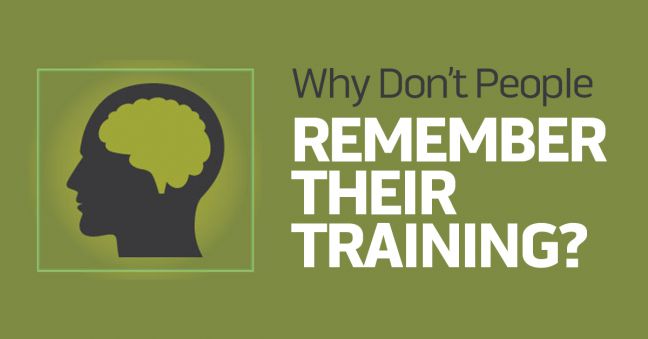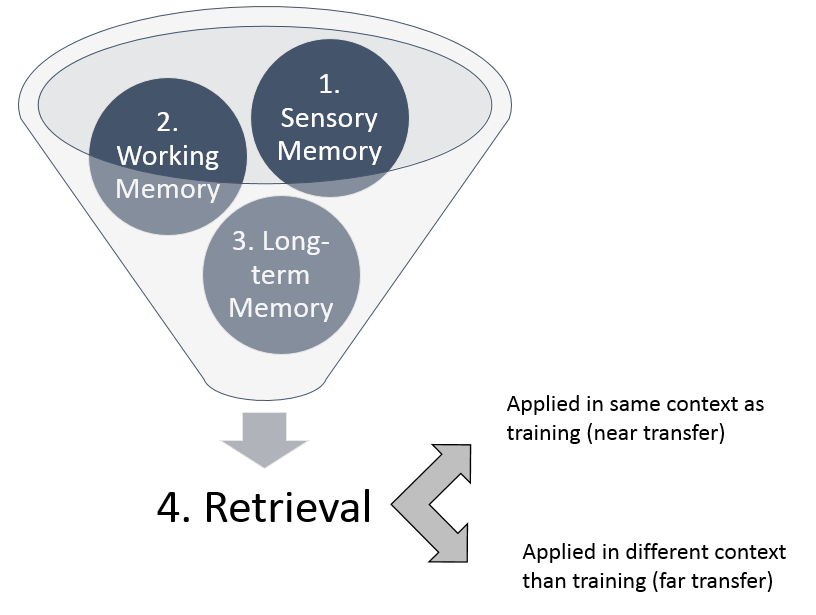
You tell them, and you tell them, and you tell them again, and they still don’t learn.
Sound familiar? Have you ever uttered these words to yourself after a training session?
If so, you may need to remind yourself of some old cliches:
- Telling ain’t training
- Learners aren’t empty vessels you pour information into
- Don’t be the sage on the stage
- Don’t spray and pray
So if you hold training sessions, and your employees seem to forget the training immediately, it may be time to quit blaming them and turn your thoughts inward: what can you do to create more memorable training experiences? How can you help workers remember and apply what they learned during training when they’re back on the job?
To that end, we’re going to give you a quick overview of how people process, store, and later retrieve information. This is the first step to making training that’s more memorable.
- Learning Management Systems
- Online Workforce Training Courses
- Incident Management Software
- Mobile Training Apps
Why People Don’t Remember Their Training
But why, you ask? Why can’t I just tell a person something once and assume they’ll understand, remember, and then later use that information when it’s needed on the job?
To understand that, it’s important to know and understand five steps that explain how people learn during training and later apply that information on the job. Those five steps are listed below.
- Sensory Information: Our senses (sight, hearing, etc.) are bombarded with information. We focus on some of it. This phase lasts only a very brief time–a moment.
- Working Memory: We process or actively “work on/think about” the information from our senses with our working memory. This is also sometimes called our short-term memory. People can keep only a small amount of information in the working memory. And by small, we mean small—about 4-7 “pieces” of information. To make things worse, we can keep information in our working memory for only a very short time period—maybe 10-15 seconds.
- Long-Term Memory: Some of the information from our working memory is then stored in our long-term memory. The rest of that information that is not stored in long term memory is lost.
- Retrieval and Application: Ideally, information that’s stored in the long-term memory is later retrieved and applied on the job when it’s needed. But that retrieval and use is not a guarantee.
- Near Transfer and Far Transfer: Near transfer is using the information in the same context in which you were taught it. Far transfer is using it in a brand new context. Both are good, but it’s harder to get far transfer, and far transfer often creates great value because it’s innovative.
Here’s what that looks like, metaphorically:
There are two points in mentioning all this.
First, as we mentioned earlier, because simply telling something to someone isn’t the same as training that person.
And second, because there are things you can do as a trainer to help your learners with each of the five steps above. Do it well, and your training will succeed. Do it poorly, and your training will fail. So it pays to be aware of these steps and to create training that helps your learners through all the different parts of the process.
For more on this general topic, consider reading some of these articles:
- Training and the Forgetting Curve
- Using Spaced Learning to Combat the Learning Curve
- Dr. Will Thalheimer on Spaced Practice
- Learning Myths & Learning Maximizers
In addition, here are some more articles that follow directly in this series:
- More information on How People Learn (and Don’t)
- Moving information from Sensory Memory to Working Memory
And here are other articles related to effective training:
- Adult Learning Principles
- How to Write Effective Training Materials
- Metaphors, Analogies, and Similes for More Effective Training
- Formatting Training Materials for More Effective Learning
- Task Analyses for Job Training
- Different Types of Training for Different Types of Learning
- Scenario-based Learning for Advanced Job Skill Development
- Testing After Training to Assess Learning
- Match Your Graphics to Your Training Content
- 25 Simple Graphic Design Tips for More Effective Training Materials
- How to “Chunk” Training Materials
- Make Training Available on an Elective Basis
- Use Blended Learning for More Effective Workforce Training
- 8 Simple Steps to Effective Training Programs
- Using Job Aids and Other Performance Support Instead of Training
- Making Better Training Materials: Instructional Design Checklists
And don’t forget to download our free guide to learning objectives below.

How to Write Learning Objectives
All the basics about writing learning objectives for training materials.

Even over time, people can forget things they have been trained in. Like safety procedures. If you train an employee on how to properly use a piece of equipment but they are only required to use said equipment 3 times a year, they may forget the safety steps during the gaps in between. Having refresher courses every now and then can help keep them on their toes.
Munro Safety: Yes, good point.<br /><br />Here's an article about "distributive practice," which makes the same point. The idea being that it's a good idea to have people practice something repeatedly over time instead of having them jam a bunch of practice all into one session.<br /><br />http://en.wikipedia.org/wiki/Distributed_Practice